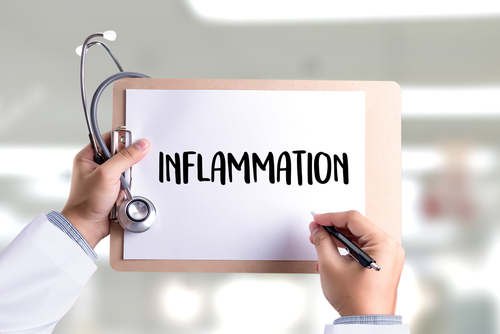
Nattokinase & Heart Health
Nattō is a traditional Japanese food made from fermented soybeans. It has a very strong smell and a sticky consistency, but is very rich in protein. To make Nattō, the soybeans are fermented with the beneficial bacteria Bacillus natto (it is sometimes listed as Bacillus subtilis natto).1 During fermentation, the Bacilli produce enzymatic peptidases, the most important of which is nattokinase.2,3
Like other proteases, nattokinase has potent anti-inflammatory activity as well as several other beneficial properties. However, probably the most important aspect of nattokinase is its fibrinolytic activity. To understand fibrinolytic activity, first one must understand the basic process of coagulation or clotting of blood. In damaged tissue, the broken blood vessel releases a compound called thromboplastin. At the same time platelets adhere to the broken edges of the vessel and disintegrate, releasing platelet factor 3. Both of these react with protein factors and calcium ions to form prothrombin activator. Once the prothrombin activator is formed, the process from prothrombin to a clot follows.11
Of course, clotting forms an important function in tissue repair. However, a clot in the blood stream (a thrombus) can be very dangerous, even fatal.
In vitro and in vivo studies have consistently demonstrated the potent fibrinolytic effect of Nattokinase.4 This enzyme is a serine protease type enzyme which appears to reduce the formation of dangerous clots and inhibit arterial thickening, both by direct fibrinolysis of clots and inhibition of the plasma protein plasminogen activator inhibitor.5 Research with nattokinase demonstrates that it may help avoid or reduce the likelihood of deep vein thrombosis, cardiac infarction, pulmonary emboli, and stroke. It appears to accomplish this via its fibrinolytic, anti-inflammatory, and modulating effect on blood pressure. Studies on hypertension demonstrate an average drop of 10.9% in Systolic Blood Pressure and a 9.7 percent drop in Diastolic Blood Pressure.6,7,21
Blood clots (thrombi) form when strands of fibrin accumulate in the circulatory system. These clots can cause blockage of blood flow. If blood flow is blocked, the oxygen supply to that tissue is cut off and it eventually dies. In the heart, this can result in myocardial infarction (heart attack). In the brain, it can result in strokes or mini-strokes. Deep vein thrombosis can result in pulmonary emboli. All these events can be life-threatening. An in vitro study, not only demonstrated the powerful fibrinolytic activity of nattokinase but also significantly reduced the aggregation of red blood cells and lowered whole blood viscosity. The net results are vascular conditions that are less likely to produce blood clots. The authors suggest that nattokinase possesses very real potential as a therapeutic agent in cardiovascular health.8
As a result of scientific research, nattokinase is available as a dietary supplement for human use. Because nattokinase is considered a systemic enzyme, it is important to demonstrate its absorption from the GI tract. An in vivo study of the duodenal absorption of nattokinase in rats showed intact absorption of the enzyme. This was based upon the subsequent degradation of plasma fibrinogen clearly demonstrating transport of nattokinase across the intestinal tract. The action of nattokinase on the cleavage of fibrinogen in the plasma was remarkably prolonged being present in plasma samples drawn 3 to 5 hours after administration of the enzyme.9
The process of forming a clot is complex and involves several enzymes. However, the body mainly produces one central enzyme for dissolving a clot, plasmin. It happens that the properties of nattokinase are very similar to plasmin. Nattokinase is particularly effective because it enhances the body’s natural ability to fight blood clots in several different ways. It dissolves fibrin directly and appears to enhance the body’s natural production of both plasmin and other clot-dissolving enzymes like urokinase. An in vivo study was undertaken to demonstrate the thrombolytic activity of nattokinase, plasmin, and elastase on an induced clot in the common carotid artery of laboratory rats. The results indicate that the thrombolytic activity of nattokinase is stronger than that of plasmin or elastase in vivo in this model.10
A study conducted with natto on 12 healthy adults (6 men and 6 women, between the ages of 21 and 55) sought to demonstrate fibrinolytic activity. The volunteers were given 200 grams of natto (the food) before breakfast, then their fibrinolytic activity was tested over time. The results indicate natto generates an increased ability to dissolve blood clots. As a control, researchers later fed the same amount of boiled soybeans to the same volunteers and tracked their fibrinolytic activity. The tests showed no significant change.2
The accumulation of fibrin in blood vessels significantly increases the likelihood of thrombosis formation resulting in a cardiovascular event. For thrombolytic therapy, microbial fibrinolytic enzymes are now much more accepted. The physiochemical properties of this enzyme is becoming well characterized and its effectiveness in thrombolysis in vivo has been further identified.12,13
A fascinating study was conducted to measure the effect of nattokinase in the prevention of deep vein thrombosis and superficial vein thrombosis on extended flights of 7-8 hours on high-risk individuals. The nattokinase had no thromboses. The placebo group had 5 deep vein thromboses and 2 superficial vein thromboses or 7.6% of 94 individuals. After the flight, the degree of edema was increased by 12% in the placebo group and decreased and the nattokinase group decreased by 15%. The authors conclude that nattokinase was effective in reducing thrombotic events and in controlling edema in high-risk subjects on long flights.14
In a study following 238 high-risk patients for stroke, the authors demonstrated a significant relationship between increased common carotid artery intima-media thickness (CCA-IMT) and the occurrence of myocardial infarction and stroke. For each increment of 0.1 mm in CCA-IMT the probability of experiencing recurrent stroke increased by 18.0%.15
A study with rat femoral artery investigating the effect of dietary supplementation with natto extracts on the intimal thickening of arteries was conducted. It was shown that dietary natto extract supplementation suppressed intimal thickening (0.06 +/- 0.01; P < 0.05) compared with the control group. These findings suggest that natto extracts, because of their thrombolytic activity, suppress intimal thickening after the vascular injury as a result of the inhibition of thrombi formation.16,18
In another study by the same group, they demonstrated that nattokinase (NK) inactivates plasminogen activator inhibitor type 1, which in turn potentiates fibrinolytic activity. Further, they investigated the effect on neointima formation and on thrombolysis at the site of endothelial injury. They conclude that dietary natto-extracts supplementation suppress intimal thickening produced by endothelial injury in rat femoral artery. These effects are at least partially attributable to NK, which showed enhanced thrombolysis near the vessel wall.17,18,19
At least 20 or more proteins form amyloid fibrils, which are causative agents in Alzheimer’s disease, prion disease, and systematic amyloidosis. Improving amyloid clearance is a major target of the therapy for these diseases. Degradation of amyloids may help prevent or at least alleviate these diseases. In this study, the authors demonstrated the amyloid-degrading ability of nattokinase. They also determined that this ability is shared by proteinase K and subtilisin, but not by trypsin or plasmin.20
While more research is needed, it seems clear that nattokinase offers significant benefits to those who are at risk for a cardiovascular event. Indeed, nattokinase may reduce the risk of deep vein thrombosis, myocardial infarction, pulmonary emboli and stroke. Further, its effect to reduce the thickness of the intima-media of arterial walls may result in reduced blood pressure as well as other risk factors like atherosclerosis. The demonstrated reduction of the aggregation of red blood cells and lowered whole blood viscosity leads one to conclude that nattokinase helps provide vascular conditions that are less likely to produce blood clots. Additional research is needed in the area of amyloid degradation. Nattokinase or related compounds may offer hope for the prevention and treatment of amyloid-related diseases.
Nattokinase has anticoagulant properties. It is recommended that health care professionals carefully review patient profiles before using nattokinase. This is especially true if patients are taking aspirin, coumadin or other medicines that increase clotting time.
References
- Healthy Microbe “Bacillus natto”. Japan Bio Science Laboratory Co. Ltd. Sumi H.
- Purification and Characterization of a Strong Fibrinolytic Enzyme (Nattokinase) in the Vegetable Cheese Natto, a Popular Soybean Fermented Food in Japan. Biochemical and Biophysical Research Communications, Vol. 197, Issue 3, 30 December 1993, pp. 1340-1347 Fujita M., Nomura K., Hong K., Ito Y., Asada A. and Nishimuro S. Jcr Pharmaceut Co Ltd, Biotechnol Res Labs, 3 2 61 Takatsukadai, Nishi Ku, Kobe 65122, Japan
- A novel fibrinolytic enzyme (nattokinase) in the vegetable cheese Natto; a typical and popular soybean food in the Japanese diet Experientia 1987, Oct 15; 43(10):1110-1. H. Sumi, H. Hamada, H. Tsushima, H. Mihara and H. Muraki** Department of Physiology, Miyazaki Medical College, Miyazaki 889-16 (Japan), Department of Fundamental Natural Science, Okayama University’ of Science, Okayama 700 (Japan), and **Department of Fermentation Technology, Faculty of Engineering, Yamanashi University, Kofu 400 (Japan), 23 June 1986
- Enhancement of the Fibrinolytic Activity in Plasma by Oral Administration of Nattokinases
Acta Haematol 1990; 84:139-143. Hiroyuki Sumia, Hiroki Hamadab, Koichiro Nakanishic, Hajime Hiratanic
aDepartment of Physiology, Miyazaki Medical College, Miyazaki, Japan; bDepartment of Biochemistry, Oklahoma State University, Okla., USA; cBiochemistry Research Laboratories, JCR Pharmaceuticals, Kobe, Japan - Determination and Properties of the Fibrinolysis Accelerating Substance (FAS) in Japanese Fermented Soybean “Natto”. Nippon Nogeikagaku Kaishi. 74 (11) 1259-1264 (2000)
Sumi Hiroyuki, Sasaki Tomohiro, Yatagai Chieko, Kozaki Yasutaka
Kurashiki Univ. Sci. and the Arts, Coll. Sci. and Industrial Technol., JPN - Prevent Heart Attack and Stroke with Potent Enzyme that Dissolves Deadly Blood Clots in Hours. Health Sciences Institute, March 2002.
- Effect of Natto Diet on Blood Pressure. JTTAS, 1995. Maruyama M, Sumi H..
- Effects of nattokinase, a pro-fibrinolytic enzyme, on red blood cell aggregation and whole blood viscosity. Clin Hemorheol Microcirc 2006; 35(1-2):139-42.
Pais E, Alexy T, Holsworth RE, Meiselman HJ - Transport of Nattokinase across the Rat Intestinal Tract. Biological & Pharmaceutical Bulletin Vol.18 , No.9 (1995) pp. 1194-1196
Mitsugu Fujita1, Kyongsu Hong1, Yae Ito1, Satoru Misawa2, Naoto Takeuchi2, Kimio Kariya3 and Satoshi Nishimuro4
1) Biotechnology Research Laboratories, JCR Pharmaceuticals Co., Ltd.
2) Pharmaceuticals and Biotechnology Laboratory, Japan Energy Corporation
3) Department of Pharmacology, Faculty of Pharmaceutical Sciences, Kobe-Gakuin University
4) Biotechnology Research Laboratories, JCR Pharmaceuticals Co., Ltd. - Thrombolytic Effect of Nattokinase on a Chemically Induced Thrombosis Model in Rat. Biological & Pharmaceutical Bulletin Vol.18 , No.10 (1995) pp.1387-1391
Mitsugu Fujita1, Kyongsu Hong1, Yae Ito1, Rie Fujii2, Kimio KARIYA2 and Satoshi NISHIMURO3
1) Biotechnology Research Laboratories, JCR Pharmaceuticals Co., Ltd.
2) Department of Pharmacology, Faculty of Pharmaceutical Sciences, Kobe-Gakuin University
3) Biotechnology Research Laboratories, JCR Pharmaceuticals Co., Ltd. - Function of the Human Body. Guyton, A.. WB Saunders pp. 83-84
- Microbial fibrinolytic enzymes: an overview of source, production, properties, and thrombolytic activity in vivo. Applied Microbiology and Biotechnology Vol. 69, No. 2, November, 2005, pp- 126-132
Yong Peng1, 2, Xiaojuan Yang1, 3 and Yizheng Zhang1 - College of Life Sciences, Sichuan University, Chengdu, 610064, PR China
- Department of Molecular and Cellular Biochemistry, Ohio State University, Columbus, OH, USA
- Program of Molecular, Cellular and Developmental Biology, Ohio State University, Columbus, OH, USA
- Nattokinase for prevention of thrombosis. Am J Health Syst Pharm, 63(12): 1121-3 2006
Tai MW , Sweet BV - Prevention of Venous Thrombosis in Long-Haul Flights with Flite Tabs: The LONFLIT-FLITE Randomized, Controlled Trial Angiology, Vol. 54, No. 5, 531-539 (2003) M.R. Cesarone, et al.
- Common Carotid Artery Intima-Media Thickness and the Risk of Stroke Recurrence. Stroke. 2006; 37:1913
Georgios Tsivgoulis, MD; Konstantinos Vemmos, MD; et al.
From the Department of Neurology (G.T., K.Spengos, D.V.), University of Athens, “Eginition” Hospital, Athens, Greece; and the Acute Stroke Unit (K.V., C.P., E.M., K.Stamatelopoulos, N.Z.), Department of Clinical Therapeutics, University of Athens, “Alexandra” Hospital, Athens, Greece. - Dietary supplementation with fermented soybeans suppresses intimal thickening. Nutrition Volume 19, Issue 3, March 2003, Pages 261-264
Yasuhiro Suzuki PhD, Kazunao Kondo PhD, et al. - Dietary supplementation of fermented soybean, natto, suppresses intimal thickening and modulates the lysis of mural thrombi after endothelial injury in rat femoral artery. Life Sciences
Volume 73, Issue 10, 25 July 2003, Pages 1289-1298
Yasuhiro Suzuki1, , Kazunao Kondo1, Yuji Matsumoto1, Bing-Qing Zhao1, Kenichi Otsuguro1, Tetsuya Maeda2, Yoshinori Tsukamoto2, Tetsumei Urano3 and Kazuo Umemura1 - Department of Pharmacology, Hamamatsu University School of Medicine, 1-20-1 Handayama, Hamamatsu City, Shizuoka, 431-3192, Japan
- Mitsukan Group Corporation, 2-6 Nakamura-cho, Handa City, Aichi, 475-8585, Japan
- Department of Physiology, Hamamatsu University School of Medicine, 1-20-1 Handayama, Hamamatsu City, Shizuoka, 431-3192, Japan
- Blood Viscosity and Elevated Carotid Intima-Media Thickness in Men and Women: The Edinburgh Artery Study. Circulation. 1998; 97:1467-1473. Amanda J. Lee, PhD; Philip I. Mowbray, BSc; Gordon D.O. Lowe, FRCP; Ann Rumley, PhD; F. Gerald R. Fowkes, FRCPE; ; Paul L. Allan, FRCR From the Wolfson Unit for Prevention of Peripheral Vascular Diseases, Department of Public Health Sciences, Edinburgh University Medical School (A.J.L., P.I.M., F.G.R.F.); the University Department of Medicine, Royal Infirmary, Glasgow (G.D.O.L., A.R.); and the Department of Radiology, The Royal Infirmary of Edinburgh NHS Trust (P.L.A.), UK.
- Nattokinase decreases plasma levels of fibrinogen, factor VII, and factor VIII in human subjects. Nutrient Research, Volume 29, Issue 3, Pages 145-220 (March 2009) Chien-Hsun Hsia, Ming-Ching Shen, Jen-Shiou Lin, Yao-Ke Wen, Kai-Lin Hwang, Thau-Ming Cham, Nae-Cherng Yang
- Amyloid-Degrading Ability of Nattokinase from Bacillus subtilis Natto. J. Agric. Food Chem., 2009, 57 (2), pp 503–508 Ruei-Lin Hsu1, Kung-Ta Lee2, Jung-Hao Wang2, Lily Y.-L. Lee1 and Rita P.-Y. Chen1
- Effects of Nattokinase on Blood Pressure: A Randomized, Controlled Trial. Hypertension Research 31, 1583–1588 (2008) Ji Young Kim 1,2, Si Nae Gum2,3, Jean Kyung Paik2,4,5,
- Yonsei University Research Institute of Science for Aging, Yonsei University, Seoul, Korea
- National Research Laboratory of Clinical Nutrigenetics/Nutrigenomics, Yonsei University, Seoul, Korea
- Department of Food and Nutrition, College of Human Ecology, Yonsei University, Seoul, Korea
- Department of Food and Nutrition, Brain Korea 21 Project, Yonsei University, Seoul, Korea
- Seoul Fellowship, Seoul, Korea




